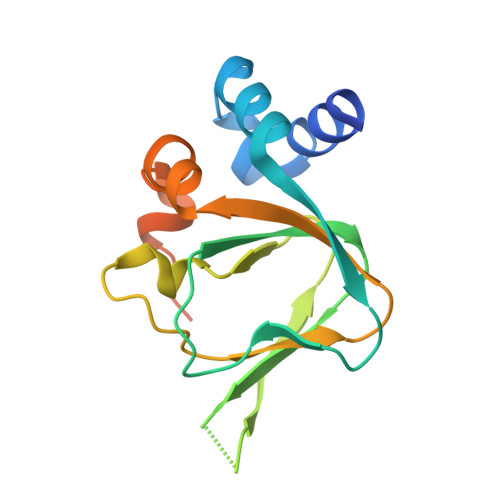Structural Basis for Cyclic-Nucleotide Selectivity and cGMP-Selective Activation of PKG I.
Huang, G.Y., Kim, J.J., Reger, A.S., Lorenz, R., Moon, E.W., Zhao, C., Casteel, D.E., Bertinetti, D., Vanschouwen, B., Selvaratnam, R., Pflugrath, J.W., Sankaran, B., Melacini, G., Herberg, F.W., Kim, C.(2014) Structure 22: 116-124
- PubMed: 24239458
- DOI: https://doi.org/10.1016/j.str.2013.09.021
- Primary Citation of Related Structures:
4KU7, 4KU8 - PubMed Abstract:
Cyclic guanosine monophosphate (cGMP) and cyclic AMP (cAMP)-dependent protein kinases (PKG and PKA) are closely related homologs, and the cyclic nucleotide specificity of each kinase is crucial for keeping the two signaling pathways segregated, but the molecular mechanism of cyclic nucleotide selectivity is unknown. Here, we report that the PKG Iβ C-terminal cyclic nucleotide binding domain (CNB-B) is highly selective for cGMP binding, and we have solved crystal structures of CNB-B with and without bound cGMP. These structures, combined with a comprehensive mutagenic analysis, allowed us to identify Leu296 and Arg297 as key residues that mediate cGMP selectivity. In addition, by comparing the cGMP bound and unbound structures, we observed large conformational changes in the C-terminal helices in response to cGMP binding, which were stabilized by recruitment of Tyr351 as a "capping residue" for cGMP. The observed rearrangements of the C-terminal helices provide a mechanical insight into release of the catalytic domain and kinase activation.
Organizational Affiliation:
Verna and Marrs McLean Department of Biochemistry and Molecular Biology, Baylor College of Medicine, Houston, TX 77030, USA.
















